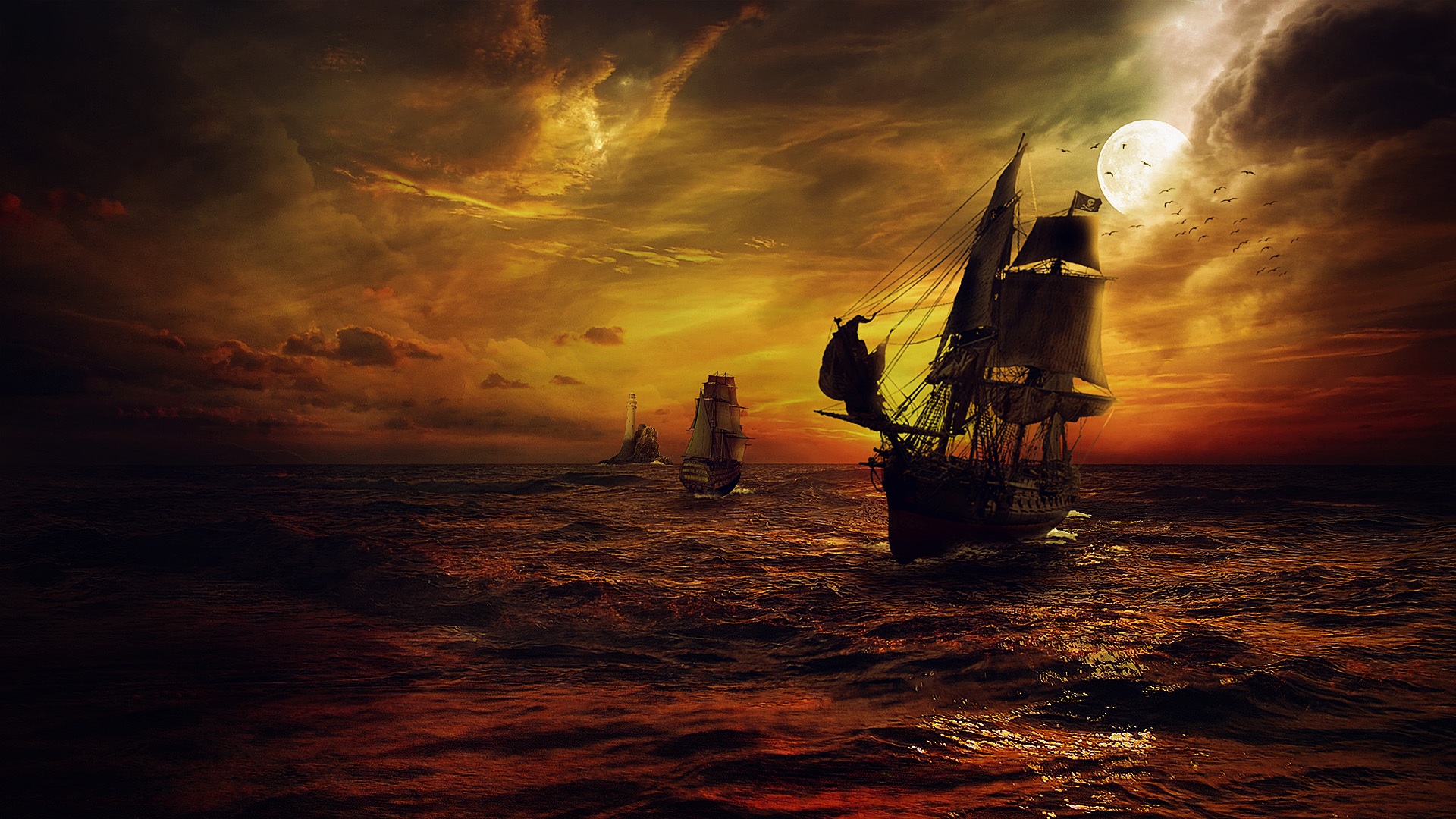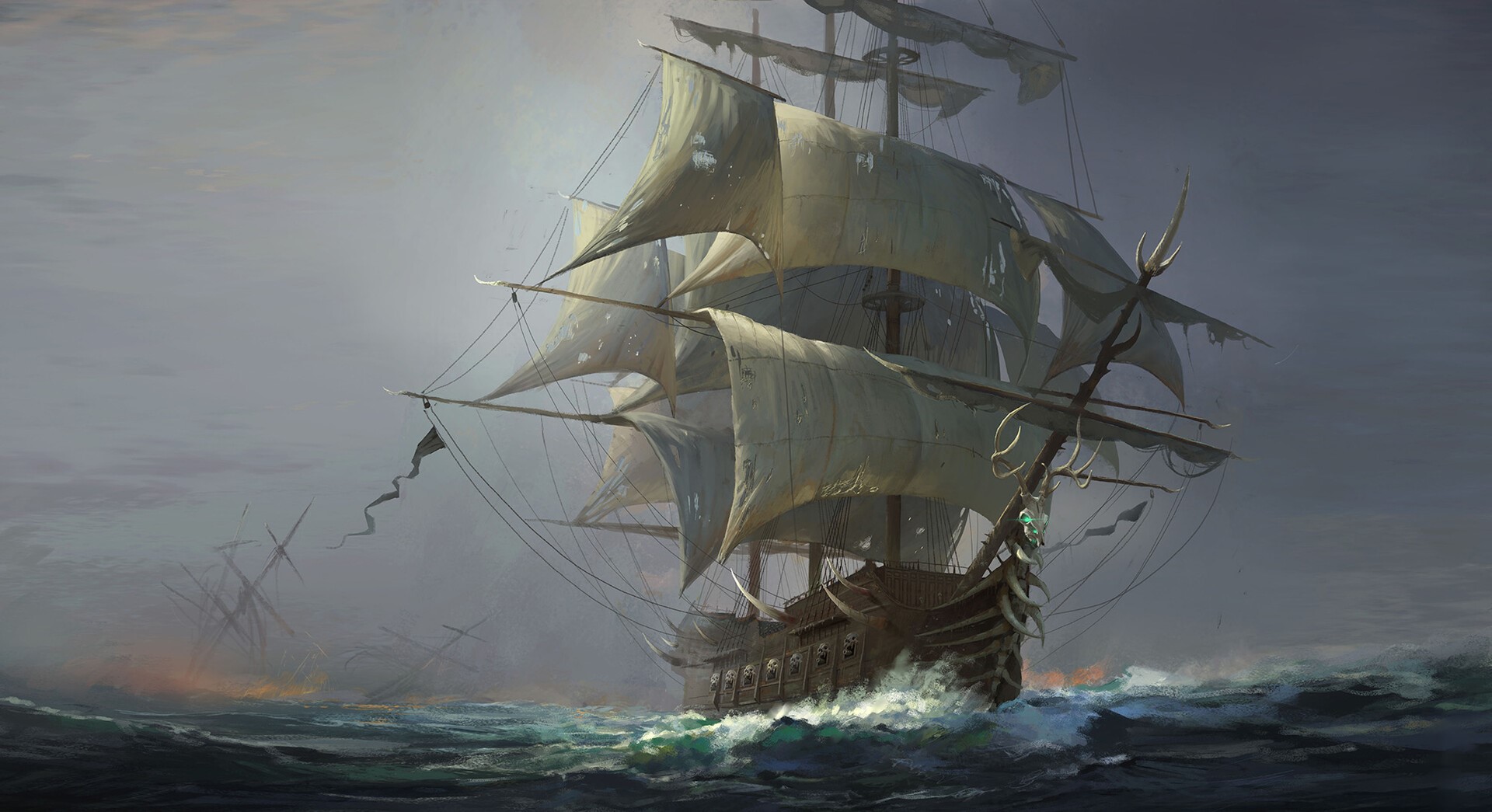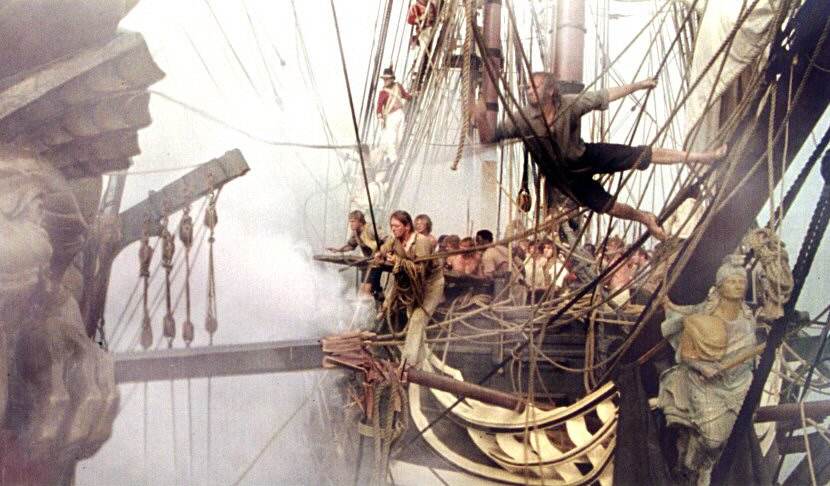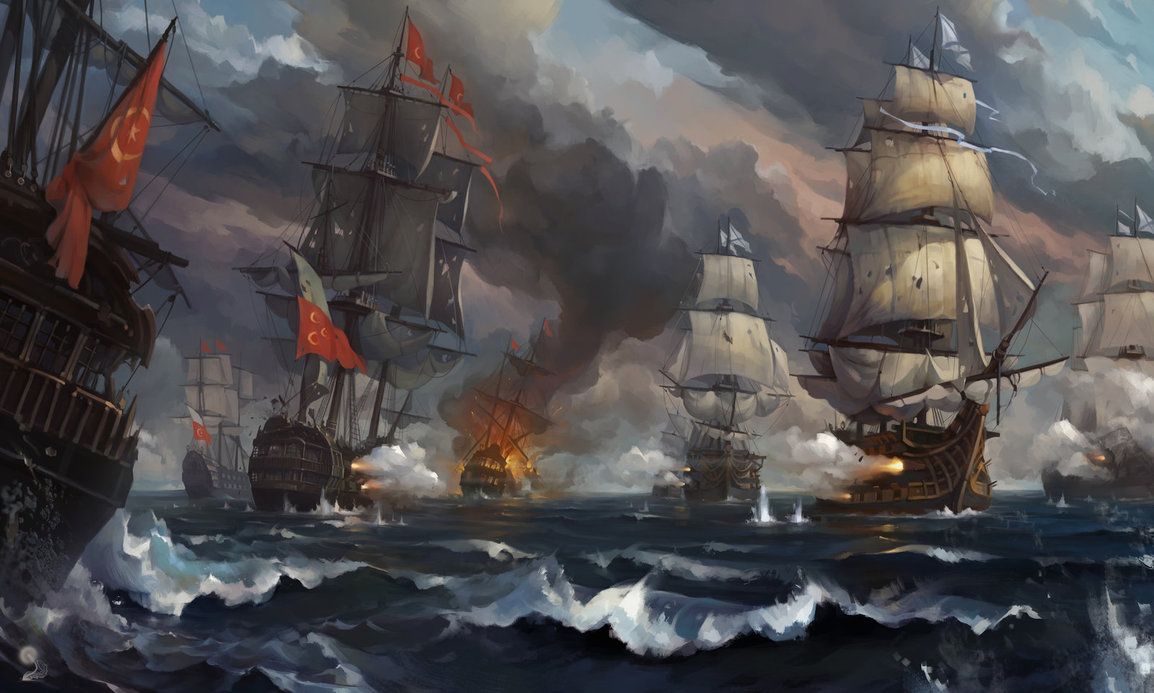Naval Combat
Welcome to Cimmerian Shade's Naval combat ruleset. This is a guide for combat to allow for ship to ship combat from both air and sea. GM discresion is always first and foremost but this can act as a guide to help with enjoying combat. This guide covers both air and sea combat for the world. There are a few new skills that have been added to address ship needs. There are many ships that are in the world, some on the sea, some in the air. Some that can do both. See below for more information.
Definition of Terms
- Maneuverability: This is the target difficulty to get successes to perform an evasive or aggressive maneuver. botched rolls negatively effect Movement and potentially direction. The helm and the ship design effect this rating
- Penalties: this is the effect of piloting the helm, these vary from helm to helm.
- Exhaustion: Exhaustion requires rest after use for 1.5 x hours managed. so if you pilot for 8 hours you will need to rest for 12.
- Movement: The number of hex a ship can move which can be reduced by failed maneuvers. 1 hex is used to change elevation up or down
- Hardpoint: a hardpoint is a mount for ship based artillery weapons, sometimes called siege engineers or war machines. they come in all shapes and sizes, and suggestions for a hardpoint can be approved by a GM, several machines have been outlined as examples.
- Helms: This is the command and control of a vessel, it also for our game terms represents the power source for the ships along with the ship design.
- Boarding: The action of putting two ships close enough together so that crew from either ship can come together to fight. see boarding party for more details.
- Landing Ground/Landing Sea: Airships that can land on ground or sea cannot have weapons that aim down. Though side mounted weapons can fire at ground targets. This requires distance as they are limited to a 30 degree down angle. Craft that cannot land land on ground or sea and require an air hanger to port, can have weapons that allow for a 45 degree down angle.
-
Ammo: Access to ammo depends on the ammo desired, difficulty to source is based on character resources, finance and regional access and GM approval.
GM Guidelines:
- Easy: available to be sourced with minimal resource and finance requirements
- Moderate: available to be sourced with moderate resource and finance requirements
- Difficult: difficult to be sourced and has moderate resource and finance requirements along with the proper influences to acquire the contacts
- Rare: Very difficult to be sourced and has high resource and finance requirements along with the proper influences to acquire the contacts, likely quests routine efforts to maintain access to the resources
Ship Game Mechanics
Crew Roles
The purpose of crew roles are to ensure all party members have activities they can be a part of during ship combat. Those with range abilities can use them against enemy ships and crews but there are also a number of other activities that can be done.- Helm and Rigging Control: The helm is who controls movement, the rigging control team is an extension of the helm and are only there for roleplay and mishap table purposes, reduction in rigging control crew effects movement or maneuverability)
- Gunners per hard point type: # crew per hardpoint and each "type" of hardpoint is lead by a player or NPC "gunner" so all the scorpions would be one type and heavy catapults another
- Damage Control: Crew dedicated to the repair of the ship in or out of combat the fire dmg per round and dmg per round that the crew can handle should be indicated in advance of the ship goes "under way". this is important to have defined in advance before combat
- Boarding Party: Any crew members who are available once the two ships are within range. Any crew member can throw a grappling line with a dex + melee skill to hit and str + melee
Moving your Ship
Helm leader controls ship movement this can be a PC or an NPC. A ships movement is calculated by adding the ship movement rating to the helm movement rating which will equal the total ship movement rating. as example, if your ship has a movement of 4 and you also have a Minor Telepathic helm with a movement rating of 1 means your ship has a total movement of 5. the Helm can also roll to increase movement. each success increases the movement to a maximum of 25% of the ships max movement. Doing this doubles the penalty of the helm. Each turn your ship can make one hex turn, this is a single turn not a full rotation. to make additional turns you must roll for combat maneuvers.Ship Movement calculation
- Ship Movement + Helm Movement = Total Movement
Temporary Increasing Ship Movement
- Roll: Int + Navigation skill: difficult=Helm rating, GM discretion
- 1-3 success = +1 movement of ship
- 4+ success = +2 movement of ship
- Penalty: doubles helm penalty
Ship Combat Maneuvers
A ship can only make 1 move with out your helm making rolls for combat maneuvers, the helm can at times force the ship to perform far more heroic acts and push the ships design limits. the difficulty is base don the helm difficulty rating.Combat Turns
- Roll: Dex + Navigation skill: difficult=Helm rating, GM discretion
- 1-3 success = 1 hex turn or 1 elevation change
- 4+ success = 2 hex turns or 2 elevation change
Ship Weapon Combat
Firing Weapon
after Loaded the lead gunner will aim and fire the weapon. You must declare your critical success target in advance. if you get or more successes you get to hit your target. This can be a person, Rigging, Steering, or other visible target. if a weapon does Double the DMG threshold of the ship. Then the shot is considered a mishap and will roll on the mishap table. (See Appendix A)- Roll: Int + Siege Gunner: aiming difficulty=base 8, GM discretion
- success: hits ship
- 5+ success: Declared target is hit
- failure: misses
- critical failure: misfire, weapon broken for 2 turns
Boarding
Any crew members who are available once the two ships are within range. Any crew member can throw a grappling line with a dex + melee skill to hit and when enough are attached, GM discression then a STR + melee roll for the "Crew" to pull together. crew members can cut lines 1 per turn per crew free.New Skills added
Navigation: This gives the ability to use Compasses, maps, Lead line, Log line, Sand glass, Cross staff, Nocturnal, Quadrant Astrolabe and other aeronautical and nautical tools to allow them to navigate ships using the stars.
Shipwright/Repair: This is the knowledge of ship design and construction, it is the skill that is used along with intelligence or dexterity to fix a ship. this skill can fix both normal and aggravated damage but certain materials or tools are required. aggravated damage cannot be healed "underway" and most be taken care of in port. Normal damage can be repaired with a repair kit as well as materials to repair. 1 tonne of materials can repair 2 levels of damage
Siege Gunner: Knowledge on how to load, target and shoot mounted siege equipment. High levels of siege gunner along with shipwright can build and repair hardpoints
Appendix A: Mishap table
Roll: Each ship has a DMG threshold, if a weapon doubles that number in a one hit. Roll 1d10.
- Crew knocked out (crew not dead but not able to perform activities)
- Fire!! (ship takes dmg per round, ignores threshold)
- Sail and rigging damage (reduces Movement)
- Hardpoint destroyed (weapon destroyed and unable to repair with out drydock)
- Elevation reduced/flooding (ship sinks/looses altitude X per round)
- Crew killed/knocked off craft (crew removed from ship)
- Helm damage (reduces maneuverability)
- Hardpoint damaged (hardpoint disabled but able to repair with skills)
- Sail and rigging damage (reduces Movement)
- Crew knocked out (crew not dead but not able to perform activities)
Appendix B: Ship Health and Damage
Ship Health: Alls Ships have 10 health points that represent the shp iteself. all ships get 1 point of armour. Ships can have more points of armour and have to be justified in their design and approved by the GM. Sea faring Ships can hve more armour than their airship counterparts
Ship Damage: Two types of Damage, Normal and aggravated. Aggravated damage cannot be healed by normal means outisde a drydock. only Normal damage can be repaired while underway.
Cost of repairs: Aggravated damage costs X and minor ship repair materials cost Y and are R tones per repair effort. See GM for cost amounts.
Fire: When Fire hits, it does X damage per 2 square feet on impact and then per round. there is a base value show in the weapon examples but its up the the GM discression. Fire can be combatted by fire suppression teams which can put out the fire. The damage control team should have their Dmg per fire and dmg per round ratings defined in advance of the scene.
Crew: Total Crew represents the total amount of humanoids the ship is needed to run the ship and its weapons easily and with redundancy. This excludes any humanoids on board that are designated as cargo/passengers. The Minimum crew is the absolute minimum a ship can be crewed with. During combat crewmen can be killed/disabled/removed from play. Hardpoints automatically are staffed with new crew as they fall until the minum amount is met. The ships captain can choose to man the guns or take penalties for movement and manuverability under the minium crew number. The GM has discression as to the effects on the ship in those cases.
Basic Ship Health Levels with no additional armour
- Armour/No Penalty
- Maneuverability Reduced
- Hardpoint disabled
- Movement Reduced
- Hardpoint disabled
- Maneuverability Reduced
- Ability to Repair out of drydock reduced
- Maneuverability Reduced
- Ability to Repair out of drydock reduced
- Movement Reduced
- Helm Damage, limited repair options
Helm Types
There are two categories of ships sea and airships. Either of them can be modified to use the below helms. Sea faring ships are known technology they are able to have MUCH more cargo and hardpoints. They are also much slower and less maneuverable. They are however very manuverable and fast. Where the airship helms are often a closely guarded secrets by any who have such knowledge. And are a new and exotic form of travel and a brand new unknown technology. Airships have much less armour, they have fewer hardpoints and much smaller cargo capabilities.Traditional basic Helms
The Helms and rudders are control and Movement of the ship. Helm is inclusive of rigging and sail control primarily focused on propulsion but does effect maneuverability, While Rudder represents maneuverability exclusively. Though traditionally made for sea faring vessels they have been adapted to newer airships.Minor Helm and Skeg mounted rudder
The most basic of helm and rudder these are common on lower end ships or to those new to the sea and adapted for crude airships- Number Required to helm: 1
- Maneuverability: Target difficulty: 8
- Movement: 1
- Penalties: Exhaustion of the Pilot
Chain Helms and Spade rudder
An Upgrade from the Minor Helm, the Chain helms offer a greater level of control and Movement. They are common in many commercial ships as well as some warships- Number Required to helm: 1
- Maneuverability: Target difficulty: 8
- Movement: 2
- Penalties: Exhaustion of the Pilot
Major Helm and Full keel rudder
Favored by warships and large commercial vessels the Major Helm and full keel offer a great amount of Movement and control.- Number Required to helm: 2
- Maneuverability: Target difficulty: 7
- Movement: 4
- Penalties: Exhaustion of the Pilot
Rare and Advanced Helms
In the Airships the Helms represent both propulsion and control, There is far less known about how the helms work and are almost impossible to reproduce. Very few people have the knowledge to refurbish one let alone create one from scratch. Several cultures have created their own types of Helms which are listed below. Damage to an airships helm will effect both Movement and maneuverabilitySoul Helms
These helms are sacrificial alters, rituals are performed and the soul of entity strapped to the altar fuels the Helm. The Ritual leader then uses the power of the sacrificed soul to control the ship. The ritual will kill the living creature. a single soul will fuel the ship for two days.- Number Required to helm: 2, one controller and 1 sacrifice per day
- Maneuverability: Target difficulty: 6
- Movement: 5
- Penalties: This type of helm sucks the soul of the person who helms the ship. Their death is assured
Minor Blood helms
Blood helms are very taxing, they use blood of a creature to fuel them. For each point of blood used the ship can be controlled for an hour. Which means a ship will spend about 24 blood points a day to function.- Number Required to helm: 2
- Maneuverability: Target difficulty: 7
- Movement: 3
- Penalties: This helm accepts blood as its fuel to drive the ship.
Major Blood helms
Blood helms are very taxing, they use blood of a creature to fuel them. For each point of blood used the ship can be controlled for two hours. Which means a ship will spend about 12 blood points a day per person to function.- Number Required to helm: 4
- Maneuverability: Target difficulty: 6
- Movement: 5
- Penalties: This helm accepts blood as its fuel to drive the ship.
Minor Magic Helms
Magic Helms require the absorption of magical energy. Magical items can also be offered to the helm, Magical helms can be powered for over a week with certain magical items (quality and power matter). However, magic that is offered by a living creature will be less effective. The magical energies must be constantly maintained by one or many casters. With out magic actively being absorbed by the helm it will not function.(debating removing magic helm, not sure it make sense)
This helm requires magic to be infused into it
- Number Required to helm: 1 minimum
- Maneuverability: Target difficulty: 7
- Movement: 2
- Penalties: Requires the sacrifice of magic items or magical energy
Major Magic Helms
Magic Helms require the absorption of magical energy. Magical items can also be offered to the helm, Magical helms can be powered for over a week with certain magical items (quality and power matter). However, magic that is offered by a living creature will be less effective. The magical energies must be constantly maintained by one or many casters. With out magic actively being absorbed by the helm it will not function.(debating removing magic helm, not sure it make sense)
This helm requires magic to be infused into it
- Number Required to helm: 3 minimum
- Maneuverability: Target difficulty: 6
- Movement: 5
- Penalties: Requires the sacrifice of magic items or magical energy
Hard Points
hardpoints are vehicle mounted "siege" artillery weapons, war machines, that are used for combat in the air and sea. Light hardpoints are generally antipersonnel weapons though some light hardpoints are intended to attach smaller vessels. While heavy hardpoints are primarily used to inflict damage onto vessels. Though a creature being hit by a heavy hardpoint will cause significant damage.Light Hardpoints
- Scorpion: a very precise anti personnel weapon. virtually useless against ships themselves
- Small Stone: Cheap, less effective, anti personnel shot
- Targeting Difficulty: 8
- Crew Requirement: 1
- Range: 8
- Damage: 1
- Ammo: easy, safe storage
- Special: Can pierce hulls, can go through multiple creatures
- Steel Tipped Bolt: expensive anti personnel shot
- Targeting Difficulty: 8
- Crew Requirement: 1
- Range: 10
- Damage: 1
- Ammo: moderate, safe storage
- Special: Can pierce lightly armoured hulls, can go through multiple creatures
- note: These machines are particularly good at staking a vampire
- Small Fire Bolt: a bolt covered steel tipped with tar and caught on fire. This has the potential to do fire damage
- Targeting Difficulty: 8
- Crew Requirement: 1
- Range: 10
- Damage: 1 *Special
- Ammo: difficult, dangerous storage
- Special: Hits heavily doing normal dmg, then +1 dmg per round unless controlled by damage control teams;
- Notes: Speeding up loading risks catching the weapon on fire. the extra crew is to ensure safety of loading
- Light Catapult: a small catapult that can do personnel dmg and limited ship rigging damage
- Small Stone Shot: light anti ship ammunition
- Targeting Difficulty: 8
- Crew Requirement: 1
- Range: 8
- Damage: 4
- Ammo: easy, safe storage
- Metal Fragments: anti personnel shot
- Targeting Difficulty: 8
- Crew Requirement: 1
- Range: 5
- Damage: 2
- Ammo: easy, safe storage
- Special: sharp metal fragments designed to hurt personnel and potentially cut dirigibles
- Small Chain Shot: for damaging rigging designed to damage ship Movement and maneuverability
- Targeting Difficulty: 9
- Crew Requirement: 1
- Range: 4
- Damage: 1 *special
- Ammo: moderate, heavy storage
- Special: Foul up rigging to reduce Movement or maneuverability based on # successes
- Small Fire Pots: A jar filled with flammable liquid. Tar sealing the top which is set ablaze before firing
- Targeting Difficulty: 10
- Crew Requirement: 1
- Range: 8
- Damage: 2 *Special
- Ammo: rare, dangerous storage
- Special: Explodes in 4 foot diameter area spreading fire across the entire area. Fire hits for 2 dmg, then +2 dmg per round unless controlled by damage control teams;
- Notes: Speeding up loading risks breaking the ammunition. the extra crew is to ensure safety of loading
Heavy Hardpoints
- Heavy Ballista: a very accurate, huge crossbow like device it hurls large javelins and stones at great distances
- Large Bolt: long range. Intended to do damage to armour and people
- Targeting Difficulty: 8
- Crew Requirement: 2
- Range: 12
- Damage: 7
- Ammo: easy, safe storage
- Special: Can pierce hulls, can go through multiple creatures
- Large Chain shot: for damaging rigging designed to damage ship Movement and maneuverability
- Targeting Difficulty: 9
- Crew Requirement: 2
- Range: 6
- Damage: 2 *Special
- Ammo: moderate, heavy storage
- Special: Foul up rigging to reduce Movement or maneuverability based on # successes
- Large Fire Bolt: a bolt covered steel tipped with tar and caught on fire. This has the potential to do fire damage
- Targeting Difficulty: 9
- Crew Requirement: 2
- Range: 6
- Damage: 2 *Special
- Ammo: difficult, dangerous storage
- Special: Hits heavily doing normal dmg, then +2 dmg per round unless controlled by damage control teams;
- Notes: Speeding up loading risks catching the weapon on fire. the extra crew is to ensure safety of loading
- Heavy Catapults: a massive device that does tremendous damage but is difficult to aim
- Heavy Stone: long range heavy damage weapon
- Targeting Difficulty: 9
- Crew Requirement: 2
- Range: 12
- Damage: 8
- Ammo: easy, safe storage
- Large Fire Pot: A jar filled with flammable liquid. Tar sealing the top which is set ablaze before firing.
- Targeting Difficulty: 10
- Crew Requirement: 2
- Range: 5
- Damage: 4 + *Special
- Ammo: rare, dangerous storage
- Special: Explodes in 8 foot diameter area spreading fire across the entire area. Fire hits for 4 dmg, then +4 dmg per round unless controlled by damage control teams;
- Notes: Speeding up loading risks breaking the ammunition. the extra crew is to ensure safety of loading
Known Ship Designs Examples
Known Airship designs
Skyrunner
- Helm Type: Minor Helm
- Total Crew: 10
- minimum crew: 7
- Maneuverability: 4
- Cargo: 5 tonnes
- Movement: +4
- length: 31 feet
- width: 14 feet
- Built by: Ubar
- Health Levels: 11+0=11
- landing Ground: Y
- Landing Sea: Y
- Light hardpoints: 2
- 1 Foredeck,
180 firing arch - 1 Aftdeck,
180 firing arch - Heavy hardpoints: 0
BlackIron
- Helm Type: Minor or Major Helm
- Total Crew: 30
- minimum crew: 20
- Maneuverability: 2
- Cargo: 10 tonnes
- Movement: +2
- length: 45 feet
- width: 21 feet
- Built by: Ubar
- Health Levels: 11+10=21
- landing Ground: Y
- Landing Sea: Y
- Light hardpoints: 4
- 2 Port side,
120 firing arch - 2 Starboard,
120 firing arch - Heavy hardpoints: 1
- 1 Foredeck,
180 firing arch
Black Dragon
- Helm Type: Major Helm
- Total Crew: 50
- minimum crew: 35
- Maneuverability: 0
- Cargo: 15 tonnes
- Movement: +1
- length: 75 feet
- width: 36 feet
- Built by: Ubar
- Health Levels: 11+25=36
- landing Ground: Y
- Landing Sea: N
- Light hardpoints: 6
- 3 Port side,
120 firing arch - 3 Starboard,
120 firing arch - Heavy hardpoints: 4
- 1 Foredeck,
180 firing arch - 1 Aftdeck,
180 firing arch - 2 Port,
120 firing archt - 2 Starboard,
120 firing arch
Known Tall ships
Knarr
- Helm Type: Minor Helm
- Total Crew: 8
- minimum crew: 6
- Maneuverability: 4
- Cargo: 24 tonnes
- Movement: +4
- length: 54 feet
- width: 15 feet
- Built by: Many nations
- Health Levels: 11+5=16
- landing Ground: N
- Landing Sea: Y (sea only)
- Light hardpoints: 1
- 1 Foredeck,
180 firing arch - Heavy hardpoints: 0
Cog
- Helm Type: Minor or Major Helm
- Total Crew: 20
- minimum crew: 15
- Maneuverability: 2
- Cargo: 120 tonnes
- Movement: +2
- length: 82 feet
- width: 26 feet
- Built by: Many nations
- Health Levels: 11+20=31
- landing Ground: N
- Landing Sea: Y (sea only)
- Light hardpoints: 8
- 4 Port side,
120 firing arch - 4 Starboard,
120 firing arch - Heavy hardpoints: 2
- 2 Foredeck,
180 firing arch - 1 Aftdeck,
180 firing arch
Galley
- Helm Type: Major Helm
- Total Crew: 300
- minimum crew: 200
- Maneuverability: 0
- Cargo: 250-350 tonnes
- Movement: +1
- length: 150 feet
- width: 56 feet
- Built by: Many nations
- Health Levels: 11+35=46
- landing Ground: N
- Landing Sea: Y (sea only)
- Light hardpoints: 8
- Hardpoints: 4 Port side,
120 firing arch - Hardpoints: 4 Starboard,
120 firing arch - Heavy hardpoints: 10
- Hardpoints: 1 Foredeck,
180 firing arch - Hardpoints: 1 Aftdeck,
180 firing arch - Hardpoints: 4 Port,
120 firing archt - Hardpoints: 4 Starboard,
120 firing arch






Comments